Tailoring Signs to Engage Two Distinct Types of Geotourists to Geological Sites
Abstract
:1. Introduction
2. Materials and Methods
- provide value-added experiences at destinations,
- generate awareness of geoconservation and geoheritage,
- create excitement around geological landscapes and the geosciences,
- better manage tourists to avoid undesirable behaviors,
- anticipate carrying capacity,
- spend marketing funds more judiciously,
- develop signs that enthrall a universal audience.
3. Literature Review
3.1. Leisure Theory
3.2. Existing Geotourist Typologies
3.3. Tourism-Oriented Geotourist Typologies
4. Results
4.1. A Conceptual Multidisciplinary Typology
4.1.1. Geotourist Lite
4.1.2. Mass Geotourist
4.1.3. Social Geotourist
4.1.4. Classic Geotourist
4.2. Limitations
4.3. Interpretive Strata
5. Discussion
Facilitating Experiences Congruent with Expectations
6. Toward Signs and Interpretive Exhibits
6.1. Archetypal Geotourist: Information Seeking
6.2. Latent Geotourist: Novel Interpretation
7. Future Research
8. Conclusions
Funding
Acknowledgments
Conflicts of Interest
Appendix A
| Geotourist Types/Market Segments | Brief Notes on Methodology and Results | Comments | |
|---|---|---|---|
| Cohen (1979) [61] | Five modes of tourists: recreational, diversionary, experiential, experimental, existential | A seminal conceptual framework based on the pursuit of pleasure versus the quest for meaning is posited. Generally speaking, it is about the tourist’s search for the novel versus the journey to the authentic. | This general tourist typology remains apt with ‘recreational’ and ‘diversionary’ modes lending insight into latent geotourists and ‘experiential’, ‘experimental’, and ‘existential’ modes illuminating archetypal geotourists. |
| Hose (1998; 2000) [10,63] Hose (2003) [97] | Dedicated (academic) Casual (populist) Intellectually engaged Physically active Socially involved | Hose, an early expert in geotourism, devises a typology based on observations at his site. His model contrasts desired levels of interpretation (academic/populist) against format (off-site journals, on- and off-site panels). He adds the verbiage dedicated and casual (2000), reflecting the types of geotourists who want academic and populist interpretation, respectively. This early paper posits what may be the first geotourist typology and remains highly useful. Hose updates his typology as part of his Ph.D. thesis with a three-sided model adding the personifications of socialite, dilettante student (i.e., intellectually engaged-physically active), photographer and hiker (i.e., intellectually engaged, socially involved), sage, clerk, aloof leader, and private collector (i.e., socially involved, physically active). Clustered centrally in his model are the generalized personifications of the social collector, student, sociable leader, diligent student, and hammerer (i.e., a fossil or mineral enthusiast). | Highly intellectual, ‘dedicated’ geotourists hand select geosites for the purpose of education and knowledge expansion and the ‘casual’ geotourists are those who occasionally visit geosites mainly for recreation, pleasure, and some limited intellectual stimulation. This was the basis for the author’s original formulation of the latent and archetypal geotourist categories. The updated version of the typology affords less utility for the author’s purposes. Still, the personifications inform the overall framework generally and the classic geotourist (academic) specifically. His personifications may be added after data collection if deemed appropriate. |
| Mehmetoglu (2004) [66] | Collectivistic Individualistic | Group and solo visitors (collectivistic and individualistic) to a Norwegian destination of geological significance are studied. Mehmetoglu found that organized tourists opt for idle entertainment, not personal enlightenment in contrast to personal goal-oriented individualistic tourists. Surprisingly, although they are referred to as collectivistic, socializing is not as important as one might expect: novelty is more important to collectivistic tourists than social interaction. It should be noted that novelty is undeniably important to both types. | Although the study does not explicitly mention geotourists, it supports anecdotal and other scholars’ philosophies on geotourist habits. Understanding geotourists’ preferences for organized or independent travel helps inform ecological impact, openness to socializing and/or crowds, and pre-planning and tells us about mass tourist behavior. |
| Falk (2006) [62] | Four visitor identities: 1 explorer, facilitator, professional/hobbyist, experience seeker | Visitors to a science center in California are interviewed about their motivations, and content analysis revealed five visitor identities. ‘Explorer’ is the curiosity-based type with a thirst for knowledge; the ‘facilitator’ is motivated by push factors (i.e., the demands of others); the ‘professional/hobbyist’ seeks a deeper intellectual experience; and the ‘experiences seeker’ is an experience-collector. | The ‘explorer’ fits the latent geotourist and within that class, the ‘professional/hobbyist’ reflects the classic geotourist who wants a deeper experience. The ‘facilitator’ supports the mass geotourist and the ‘experience seeker’, describes geotourist lite well. Falk’s types can be distributed remarkably evenly throughout the typology, which the author discovered after devising her typology, and it lent a measure of legitimacy to its design. |
| Mao et al. (2009) [67] | Potential geotourists | In this preliminary study to inform destination development, marketing needs, visitor behavior, and geotourist preferences, members of the Geological Society of Australia (GSA) self-reported on their purpose for travel (i.e., to gain knowledge, to satisfy curiosity) in addition to their likelihood of travelling independently to geosites. | While Mao et al. do not explicitly posit types, their examination of members of the GSA contributes to wisdom about archetypal geotourists and is concomitant with Hose’s [63] findings. |
| Grant (2010) [56] | Geo-expert Geo-specialist Geo-amateur Interested visitor Aware visitor Unaware visitor | Grant’s is a conceptualized pyramid-based model based on prior knowledge, interest, and expertise. The posited typologies are gauged through a marketing lens. Depth of interpretation increases near the top of the pyramid as does expected audience size. The base represents those interested in novel entertainment. | Her ‘interested visitor’ and ‘aware visitor’ categories represent the latent geotourist with the highest market potential and entertainment requirements. Her ‘geo-expert’, ‘geo-specialist’, and ‘geo-amateur’ are degrees of archetypal geotourists: a small, knowledgeable group with limited market potential. Her ‘unaware visitor’ stumbles upon a geosite, like geotourist lite might. Having a marketing background, she points out the advantages of pinpointing the most common types of geotourists in order to better cater to them and theorizes the market can be grown through interpretive interventions. |
| Hurtado et al. (2014) [64] | Purposeful Intentional Serendipitous Accidental Incidental | Hurtado et al. applied McKercher and du Cros’ [98] cultural tourism typology model to cave tourists at a National Park in Australia, so both latent and archetypal geotourists are part of the subject group. Five types are described based on motivation (i.e., curiosity or education) and positive or negative experience. However, the researcher perceives a gap at the depth of experience end of the spectrum where ‘to know more’ can put the archetypal geotourist on the same footing with a latent geotourist. Quantitative assessment of actions taken before the visit may be a better indicator than self-reported motivations. | ‘Serendipitous’ and ‘accidental’ geotourists reflect postulated geotourist lite (latent geotourists) and ‘purposeful’ and ‘intentional’ geotourists are similar to archetypal geotourists. The ‘incidental’ geotourist is omitted from the author’s study because she sees limited use in adding this negative-experience group straightaway. This was one of the most useful studies in terms of formulating the original framework proposed in this paper. They also refer to Mao et al.’s study [67], adding to its relevance. |
| Božić & Tomić (2015) [54] | General geotourist Pure geotourist | To arrive at tourist values, visitors to several gorges in Serbia self-report their motivations for visiting via a questionnaire. Previous geological awareness was also considered. Their detailed evaluation considers many indicators, some that concern the physical, aesthetic, and interpretative aspects of destinations. Other factors related to infrastructure round out the study, which reflects a tourism marketing perspective that stresses geoconservation. | Their ‘general geotourist’ strongly supports the author’s latent geotourists and their ‘pure geotourist’ reflects archetypal geotourists with their penchant for planning (research in advance), avoidance of crowds, and knowledge-seeking tendencies. |
Appendix B
| Subjects | Factors to be Quantified and Qualified | Methods | Objectives |
|---|---|---|---|
| A selection of geosite signs in and near the Alps | Number of words Number of topics Word types (technical, thematic) Links to academic-quality information Focus (abiotic, biotic, cultural) Composition * (alignment, contrast, white space) Aesthetic appeal * (well-chosen photos, timeless) Display (already vandalized, easy to replace) | Primarily quantitative (content analysis) | Improve attention capture by determining perfect ratio Determine how much geology focus at geosites See if the public uses links to find geoscientific information off-site |
| Sign viewers | Attracting power (% of audience engagement) Holding power (% of audience sustained interaction) | Primarily quantitative (unobtrusive observation) | Gauge audience engagement with signs |
| Geotourists | Pre-planning tendency Obtainment of books (specialized field guides or touristic) Sourcing of information in advance (practical or technical) Existing geoscience awareness Time spent on- and off-site | Mixed (interviews, keyword analytics, observations, and surveys) | Confirm or adapt the visitor types postulated in the conceptual geotourist typology Determine if they can identify landforms and processes Estimate ecological-impact factor using temporal and behavioral (group versus solitary) data |
| Conceptual sign template | Attracting power (% of audience engagement) Holding power (% of audience sustained interaction) Sourcing of information in advance (practical or technical) Brochure taken/looked at | Mixed (observation and keyword analytics) | Did the intervention improve public engagement? |
References
- Gilbert, J.; Churchill, G.C. The Dolomite Mountains: Excursions through Tyrol, Carinthia, Carniola, & Friuli in 1861, 1862, & 1863; Longman, Green, Longman, Roberts, & Green: London, UK, 1864; Available online: https://archive.org/details/dolomitemountai00churgoog (accessed on 1 September 2018).
- Bonnard, C.; Forlati, F.; Scavia, C. Reppwand-Oselitzenbach landslide. In Identification and Mitigation of Large Landslide Risks in Europe: Advances in Risk Assessment; CRC Press: Piemonte, Italy, 2004; Available online: https://www.researchgate.net/publication/265493186_Reppwand_-Oselitzenbach_Landslide (accessed on 1 September 2018).
- Gordon, J. Geoheritage, geotourism and the cultural landscape: Enhancing the visitor experience and promoting geoconservation. Geosciences 2018, 8, 136. [Google Scholar] [CrossRef]
- Tourtellot, J. UNESCO’s Geoparks ‘Clarify’ Geotourism. National Geographic. 2011. Available online: https://blog.nationalgeographic.org/2011/11/16/unesos-geoparks-clarify-geotourism/#disqus_thread (accessed on 15 August 2018).
- Hose, T.A. Three Centuries (1670–1970) of Appreciating Physical Landscapes; Geological Society, London, Special Publications: London, UK, 2016; Volume 417, pp. 1–23. [Google Scholar]
- Dowling, R.K.; Newsome, D. Geotourism: The Tourism of Geology and Landscape; Goodfellow Pub.: Woodeaton, UK, 2010. [Google Scholar]
- Ji, Y. Sustainable Tourism Can Advance Global Development, UN Agency Highlights on World Day. United Nations. 27 September 2017. Available online: https://news.un.org/en/story/2017/09/567262-sustainable-tourism-can-advance-global-development-un-agency-highlights-world (accessed on 3 August 2018).
- National Parks Service. NPS Stats: National Park Service Visitor Use. U.S. Department of the Interior, National Parks Service. Available online: https://irma.nps.gov/Stats/ (accessed on 1 July 2018).
- IMFBlog. International Monetary Fund. 14 August 2017. Available online: https://0-blogs-imf-org.library.svsu.edu/2017/08/14/chart-of-the-week-icelands-tourism-eruption/ (accessed on 1 July 2018).
- Hose, T.A. European “Geotourism”—Geological interpretation and geoconservation promotion for tourists. In Geological Heritage: Its Conservation and Management; Barettino, D., Wimbledon, W.A.P., Gallego, E., Eds.; IGME: Madrid, Spain, 2000; pp. 127–146. ISBN 84-7840-417-1. [Google Scholar]
- Gordon, J.E. Rediscovering a sense of wonder: Geoheritage, geotourism and cultural landscape experiences. Geoheritage 2012, 4, 65–67. [Google Scholar] [CrossRef]
- Hjort, J.; Gordon, J.E.; Gray, M.; Hunter, M.L. Why geodiversity matters in valuing nature’s stage. Conserv. Biol. 2015, 29, 630–639. [Google Scholar] [CrossRef] [PubMed]
- Kim, S.S.; Kim, M.; Park, J.; Guo, Y. Cave tourism: Tourists’ characteristics, motivations to visit, and the segmentation of their behavior. Asia Pac. J. Tour. Res. 2008, 13, 299–318. [Google Scholar] [CrossRef]
- Newsome, D.; Dowling, R.; Leung, Y. The nature and management of geotourism: A case study of two established. iconic geotourism destinations. Tour. Manag. Perspect. 2012, 2, 19–27. [Google Scholar] [CrossRef]
- Barrie, J. A 320 Million-Year-Old Balancing Rock Formation Was Destroyed by a Group of Young People. Available online: https://inews.co.uk/news/brimham-rocks-damaged-yorkshire/ (accessed on 1 June 2018).
- Tang, F. Chinese Tourist Destroys with Three Swift Kicks What Nature Took 3000 Years to Build. South China Morning Post. 2 June 2017. Available online: https://www.scmp.com/news/china/society/article/2096657/chinese-tourist-destroys-three-swift-kicks-what-nature-took-3000 (accessed on 1 July 2018).
- Whitcomb, D. Boy Scout Leaders Topple Ancient Rock Formation, Trigger Outrage. Scientific American. Available online: https://www.scientificamerican.com/article/us-scout-leaders-topple-ancient-roc/ (accessed on 1 July 2018).
- “Helft mir, ein Paradies zu Bleiben.” [“Help Me to Remain a Paradise.”]; Das Magazin des Deutschen Alpenvereins: Munich, Germany, 2018; p. 10.
- Hunter, D. The Trump Administration’s Effect on National Parks: It’s Been a Hard Summer for Our Public Lands. Scientific American. 28 August 2017. Available online: https://blogs.scientificamerican.com/rosetta-stones/the-trump-administrations-effect-on-national-parks/ (accessed on 1 August 2018).
- Nordhaus, H. What Trump’s Shrinking of National Monuments Actually Means. National Geographic. 2 February 2018. Available online: https://news.nationalgeographic.com/2017/12/trump-shrinks-bears-ears-grand-staircase-escalante-national-monuments/ (accessed on 18 July 2018).
- Stokes, A.M.; Cook, S.D.; Drew, D. The New Trend in Travel. Travel Industry Association of America and the National Geographic Traveler Magazine. 2003. Available online: http://www.egret.us/clinton/Geotourism%20The%20New%20Trend%20in%20Travel.pdf (accessed on 15 August 2018).
- Hose, T.A. 3G’s for modern geotourism. Geoheritage 2012, 4, 7–24. [Google Scholar] [CrossRef]
- Milano, C.; Cheer, J.M.; Novelli, M. Overtourism: A Growing Global Problem. The Conversation. Available online: https://theconversation.com/overtourism-a-growing-global-problem-100029 (accessed on 1 July 2018).
- Dowling, R. Geotourism’s global growth. Geoheritage 2010, 3, 1–13. [Google Scholar] [CrossRef]
- Bayerisches Landesamt für Umwelt [Bavarian Environmental Protection Agency]. Geologie: Tiefe Einblicke in den Untergrund [Geology: Deep View into the Underground]. Available online: https://www.lfu.bayern.de/geologie/index.htm (accessed on 1 July 2018).
- Clary, R.M.; Wandersee, J.H. Lessons from US fossil parks for effective informal science education. Geoheritage 2014, 6, 241–256. [Google Scholar] [CrossRef]
- Larwood, J.; Prosser, C. Geotourism, conservation and society. Geol. Balcanica 1998, 28, 97–100. [Google Scholar]
- Rodriguez Estrada, F.C.; Davis, L.S. Improving visual communication of science through the incorporation of graphic design theories and practices into science communication. Sci. Commun. 2015, 37, 140–148. [Google Scholar] [CrossRef]
- Barrow, G.C. Interpretation planning and its role in sustainable tourism and visitor management at geoheritage sites. Int. J. Geoherit. 2013, 1, 30–38. [Google Scholar]
- Packer, J.; Ballantyne, R. Conceptualizing the visitor experience: A review of literature and development of a multifaceted model. Visit. Stud. 2016, 19, 128–143. [Google Scholar] [CrossRef]
- Wöran, B.; Arnberger, A. Exploring relationships between recreation specialization, restorative environments and mountain hikers’ flow experience. Leisure Sci. 2012, 34, 95–114. [Google Scholar] [CrossRef]
- Falk, J.H.; Storksdieck, M. Science learning in a leisure setting. J. Res. Sci. Teach. 2009, 47, 194–212. [Google Scholar] [CrossRef]
- Falk, J.H.; Ballantyne, R.; Packer, J.; Benckendorff, P. Travel and learning: A neglected tourism research area. Ann. Tour. Res. 2012, 39, 908–927. [Google Scholar] [CrossRef]
- Ryan, R.M.; Deci, E.L. Self-Determination Theory and the facilitation of intrinsic motivation, social development, and well-being. Am. Psychol. 2000, 55, 68–78. [Google Scholar] [CrossRef] [PubMed]
- Sacco, K.; Falk, J.H.; Bell, J. Informal science education: Lifelong, life-wide, life-deep. PLoS Biol. 2014, 12, e1001986. [Google Scholar] [CrossRef] [PubMed]
- Tilden, F.; Craig, R.B. Interpreting Our Heritage; The University of North Carolina Press: Chapel Hill, NC, USA, 2007; ISBN 9780807831809. [Google Scholar]
- Cachelin, A.; Paisley, K.; Dustin, D. Opportunity and obligation: A role for outdoor educators in the sustainability revolution. J. Outdoor Recreat. Educ. Leadersh. 2009, 1, 141–150. [Google Scholar] [CrossRef]
- Hausmann, A.; Toivonen, T.; Slotow, R.; Tenkanen, H.; Moilanen, A.; Heikinheimo, V.; Di Minin, E. Social media data can be used to understand tourists’ preferences for nature-based experiences in protected areas: Social media data in protected areas. Conserv. Lett. 2018, 11, e12343. [Google Scholar] [CrossRef]
- Reden, C. The 28 Most Instagram-Worthy Places in the World to Visit. Skyscanner. Available online: https://www.skyscanner.com.au/news/inspiration/the-30-most-instagram-worthy-places-in-the-world-to-visit (accessed on 1 July 2018).
- Cooper, B.C. Instagram-Worthy Spots That Will Kill You. Fox News. 15 October 2017. Available online: http://www.foxnews.com/travel/2015/10/14/instagram-worthy-spots-that-will-kill.html (accessed on 15 August 2018).
- Ritchie, J.R.B.; Crouch, G.I. The Competitive Destination: A Sustainable Tourism Perspective; CABI Pub.: Oxon, UK, 2005. [Google Scholar]
- Cohen, E. Toward a sociology of international tourism. Soc. Res. 1972, 39, 164–182. [Google Scholar]
- Boorstin, D.J. The Image: A Guide to Pseudo-Events in America; Atheneum: New York, NY, USA, 1961; Available online: https://archive.org/details/imageorwhathapp00boor (accessed on 31 August 2018).
- Urry, J. The Tourist Gaze “Revisited”. Am. Behav. Sci. 1992, 36, 172–186. [Google Scholar] [CrossRef]
- Wandersee, J.H.; Clary, R.M. Learning on the Trail: A content analysis of a university arboretum’s exemplary interpretive science signage system. Am. Biol. Teach. 2007, 69, 16–23. [Google Scholar]
- Bitgood, S. Lessons learned from five decades of experience in visitor studies. In Proceedings of the Annual Meeting Handout, American Alliance of Museums, Baltimore, MD, USA, 21 May 2013; Available online: http://labs.aam-us.org/buildingculturalaudiences/wp-content/uploads/sites/2/2016/07/Lessons-Learned-from-Five-Decades-of-experience-in-Visitor-Studies.pdf (accessed on 15 August 2018).
- Thompson, D.; Bitgood, S. Chapter 10: The effects of sign length, letter size, and proximity on reading. Visit. Stud. 2012, 1, 101–112. [Google Scholar] [CrossRef]
- Megerle, H. Naturerlebnispfade: Neue Medien der Umweltbildung und des Landschaftsbezogenen Tourismus? Bestandsanalyse, Evaluation und Entwicklung von Qualitätsstandards [Nature Discovery Paths: A New Medium for Environmental Education and Landscape Tourism? Inventory Analysis, Evaluation, and Development of Best Practices]. Ph.D. Thesis, Geographisches Institut der Universität Tübingen, Tübingen, Germany, 2003. [Google Scholar]
- Ham, S.H. Interpretation: Making a Difference on Purpose; Fulcrum Publishing: Golden, CO, USA, 2013; ISBN 9781555917425. [Google Scholar]
- Beck, L.; Cable, T.; Knudson, L. Interpreting Cultural and Natural Heritage: For a Better World; Sagamore Publishing: Champaign, IL, USA, 2018; ISBN 9781571678652. [Google Scholar]
- Skibins, J.C.; Powell, R.B.; Stern, M.J. Exploring empirical support for interpretation’s best practices. J. Interpret. Res. 2012, 17, 25–44. [Google Scholar]
- Falk, J.H.; Storksdieck, M.; Dierking, L.D. Investigating public science interest and understanding: Evidence for the importance of free-choice learning. Public Underst. Sci. 2007, 16, 455–469. [Google Scholar] [CrossRef]
- Falk, J.H. Free-choice environmental learning: framing the discussion. Environ. Educ. Res. 2005, 11, 265–280. [Google Scholar] [CrossRef]
- Božić, S.; Tomić, N. Canyons and gorges as potential geotourism destinations in Serbia: Comparative analysis from two perspectives—General geotourists’ and pure geotourists’. Open Geosci. 2015, 7, 531–546. [Google Scholar] [CrossRef]
- Gorman, C. Landscape and Geotourism: Market Typologies and Visitor Needs. In Proceedings of the European Tourism and the Environment Conference: Promotion and Protection, Achieving the Balance, Dublin, Ireland, 11–12 October 2007. [Google Scholar]
- Grant, C. Towards a Typology of Visitors to Geosites. In Proceedings of the Second Global Geotourism Conference, Mulu, Malaysia, 17–20 April 2010. [Google Scholar]
- Stebbins, R.A. Serious leisure: A conceptual statement. Pac. Sociol. Rev. 1982, 25, 251–272. [Google Scholar] [CrossRef]
- Bryan, H. Recreation specialization revisited. J. Leisure Res. 2000, 32, 18–21. [Google Scholar] [CrossRef]
- Stebbins, R.A. Casual leisure: A conceptual statement. Leisure Stud. 1997, 16, 17–25. [Google Scholar] [CrossRef]
- Scott, D. Serious leisure and recreation specialization: An uneasy marriage. Leisure Sci. 2012, 34, 366–371. [Google Scholar] [CrossRef]
- Cohen, E. A phenomenology of tourist experiences. Sociology 1979, 13, 179–201. [Google Scholar] [CrossRef]
- Falk, J.H. An identity-centered approach to understanding museum learning. Curator 2006, 49, 151–166. [Google Scholar] [CrossRef]
- Hose, T. Mountains of fire from the present to the past—or effectively communicating the wonder of geology to tourists. Geol. Balcania 1998, 28, 77–85. [Google Scholar]
- Hurtado, H.; Dowling, R.; Sanders, D. An exploratory study to develop a geotourism typology model. Int. J. Tour. Res. 2014, 16, 608–613. [Google Scholar] [CrossRef]
- Bixler, R.D.; James, J.J. First impressions: Exploring the structure of titles for nonformal public interpretive programs. Visit. Stud. 2014, 17, 177–190. [Google Scholar] [CrossRef]
- Mehmetoglu, M.A. Typology of tourists from a different angle. Int. J. Hospital. Tour. Admin. 2004, 5, 69–90. [Google Scholar] [CrossRef]
- Mao, I.; Robinson, A.M.; Dowling, R. Potential geotourists: An Australian case study. J. Tour. 2009, 10, 71–80. [Google Scholar]
- Pralong, J.P.; Reynard, E.A. Proposal for a classification of geomorphological sites depending on their tourist value. Ital. J. Quat. Sci. 2005, 18, 315–321. [Google Scholar]
- Allan, M. Toward a Better Understanding of Motivations for a Geotourism Experience: A Self-Determination Theory Perspective; LAP LAMBERT Academic Publishing: Saarbrücken, Germany, 2012. [Google Scholar]
- Robinson, A.M. Geotourism: Who Is the Geotourist? In Proceedings of the Inaugural National Conference on Green Travel, Climate Change and Ecotourism, Adelaide, Australia, November 2008. (unpubl). [Google Scholar]
- Pearce, J.; Moscardo, G. Social Representations of Tourist Selfies: New Challenges for Sustainable Tourism. In Proceedings of the BEST EN Think Tank XV. The Environment-People Nexus in Sustainable Tourism: Finding the Balance, Skukuza, South Africa, 17–21 June 2015; pp. 59–73. [Google Scholar]
- Aquino, R.; Schänzel, H.; Hyde, K. Unearthing the geotourism experience: Geotourist perspectives at Mount Pinatubo, Philippines. Tour. Stud. 2018, 18, 41–62. [Google Scholar] [CrossRef]
- Hale, B.W. Mapping potential environmental impacts from tourists using data from social media: A case study in the Westfjords of Iceland. Environ. Manag. 2018. [Google Scholar] [CrossRef] [PubMed]
- Lagally, U.; Loth, G. Experiencing Bavaria’s geological heritage—The project “Hundred Masterpieces”. Geoheritage 2016, 9, 519–531. [Google Scholar] [CrossRef]
- Geocaching. Bayerns Schoenste Geotope [Bavaria’s Most Beautiful Geosites]. Available online: https://www.geocaching.com/bookmarks/view.aspx?guid=81c36c6c-2711-4c8a-b968-01e26c101735 (accessed on 15 August 2018).
- Moreira, J.C. Interpretative panels about the geological heritage: A case study at the Iguassu Falls National Park (Brazil). Geoheritage 2012, 4, 127–137. [Google Scholar] [CrossRef]
- Naturpark Dobratsch [Nature Park Dobratsch]. Naturpark Dobratsch Broschüre 2010 [Nature Park Dobratsch Brochures 2010]; Nature Park Dobratsch: Klagenfurt, Austria, 2010. [Google Scholar]
- Michor, H. Geschichte des Dorfes Feistritz: Gail und Hofchronik Teil I [History of the Village of Feistritz and Local Chronicle Part I]. Gemeinde Feistritz, Austria, 1950/1951. Available online: http://www.feistritz-gail.gv.at/_Resources/Persistent/def22a9e9ba7432c6c54f78c6cd508d0a92e8356/chronik1.pdf (accessed on 15 August 2018).
- Csikszentmihalyi, M. Flow and the Foundations of Positive Psychology: The Collected Works of Mihaly Csikszentmihalyi; Springer: Dordrecht, The Netherlands, 2014. [Google Scholar]
- Geopark Karnische Alpen. Home Page. Available online: http://www.geopark-karnische-alpen.at/Startpage.1447.0.html?&L=2 (accessed on 10 August 2018).
- Geopark Karnische Alpen. Research. Available online: http://www.geopark-karnische-alpen.at/Research.901.0.html?&L=2 (accessed on 10 August 2018).
- Geopark Karnische Alpen. Austrian Geoparks. Available online: http://www.geopark-karnische-alpen.at/Austrian-Geoparks.2582.0.html?&L=2 (accessed on 10 August 2018).
- Geopark Karnische Alpen. Publications. Available online: http://www.geopark-karnische-alpen.at/Publications.911.0.html?&L=2_ (accessed on 10 August 2018).
- Geopark Karnische Alpen. Six Geotrails in Geopark Carnic Alps. Available online: http://www.geopark-karnische-alpen.at/Geotrails.965.0.html?&L=0%22 (accessed on 1 September 2018).
- Geopark Karnische Alpen. Visitor Center. Available online: http://www.geopark-karnische-alpen.at/The-Visitor-Center-offers.998.0.html?&L=2 (accessed on 10 August 2018).
- Bayerisches Landesamt für Umwelt [Bavarian Environmental Protection Agency]. Geologischer Überblick Bayern [Geological Overview of Bavaria]. Available online: https://www.lfu.bayern.de/geologie/geologie_bayerns/ueberblick/index.htm (accessed on 1 July 2018).
- Miller, G. The magical number seven, plus or minus two: Some limits on our capacity for processing information. Psychol. Rev. 1956, 63, 81–97. [Google Scholar] [CrossRef] [PubMed]
- Hagen, R.; Golombisky, K. White Space Is Not Your Enemy: A Beginner’s Guide to Communicating Visually Through Graphic, Web & Multimedia Design; CAC Press: Boca Raton, FL, USA, 2017; ISBN 9780240824147. [Google Scholar]
- Williams, R. The Non-Designer’s Design Book: Design and Typographic Principles for the Visual Novice; Peachpit Press: San Francisco, CA, USA, 2008; ISBN 9780321679086. [Google Scholar]
- Vignelli, M. The Vignelli Canon; Lars Müller Publishers: Zurich, Switzerland, 2017; ISBN 3037782250. [Google Scholar]
- United States National Parks Service. Official Maps and Guides/Park Brochures. Available online: https://www.nps.gov/parkhistory/online_books/brochures/unigrid-a-f.htm (accessed on 12 August 2018).
- United States National Parks Service. Unigrid. Available online: https://www.nps.gov/parkhistory/online_books/brochures/unigrid/index.htm (accessed on 12 August 2018).
- Norman, D. The Design of Everyday Things: Revised and Expanded Edition; Basic Books: New York, NY, USA, 2013; ISBN 9788809743564. [Google Scholar]
- Wimbledon, W.A.P.; William, A.P.; Smith-Meyer, S. Geoheritage in Europe and Its Conservation; EGU General Assembly: Vienna, Austria, 2012; ISBN 978-82-426-2476-5. [Google Scholar]
- Jackson, L. We Are the Original Life Hackers. The New York Times. 30 May 2018. Available online: https://www.nytimes.com/2018/05/30/opinion/disability-design-lifehacks.html (accessed on 16 August 2018).
- North Carolina State University. Universal Design History. Center for Universal Design. Available online: https://projects.ncsu.edu/ncsu/design/cud/about_ud/udhistory.htm (accessed on 27 July 2018).
- Hose, T.A. Geotourism in England: A Two-Region Case Study Analysis. Ph.D. Thesis, University of Birmingham, Birmingham, UK, 2003. [Google Scholar]
- McKercher, B.; du Cros, H. Testing a cultural tourism typology. Int. J. Tour. Res. 2003, 5, 45–58. [Google Scholar] [CrossRef]

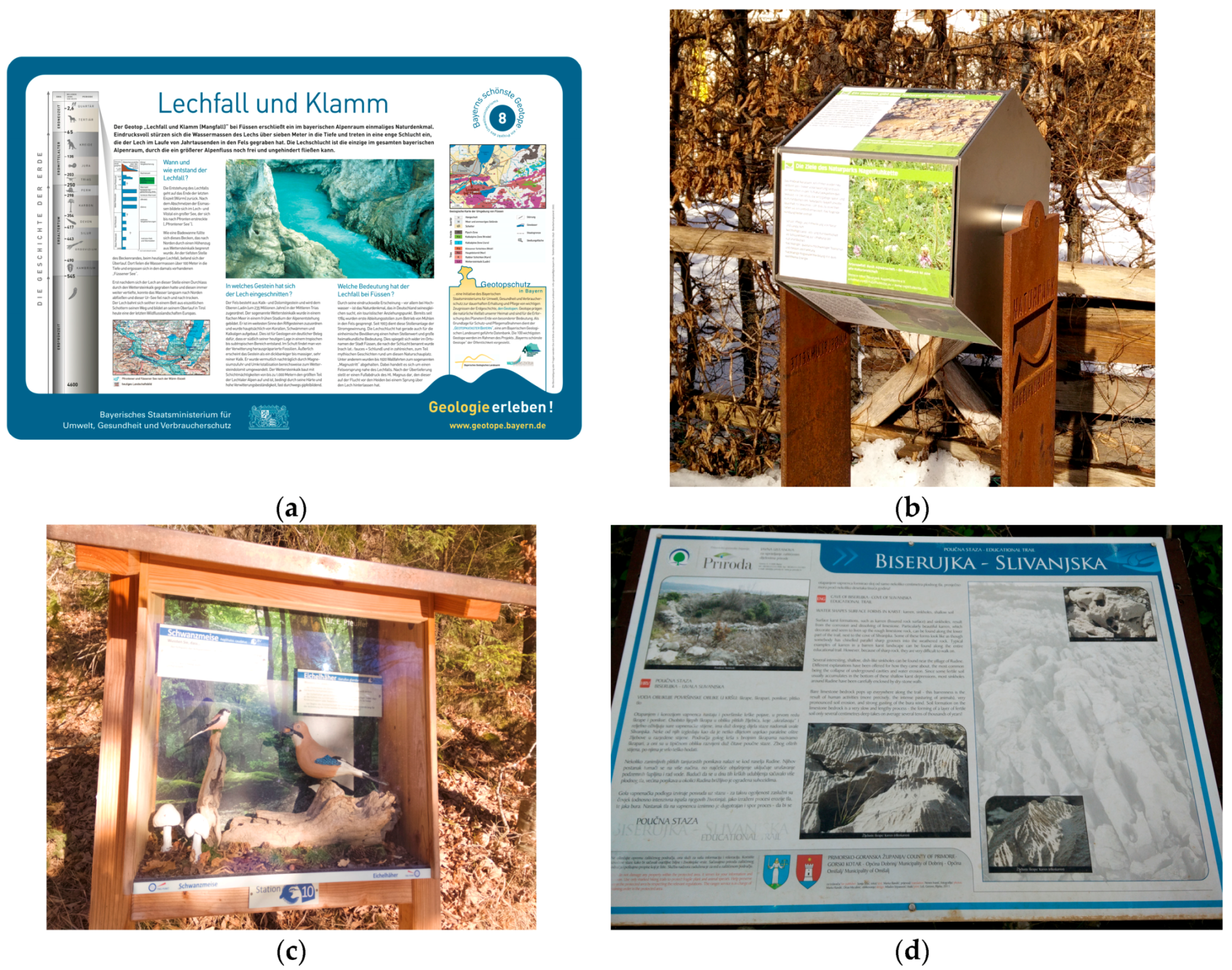

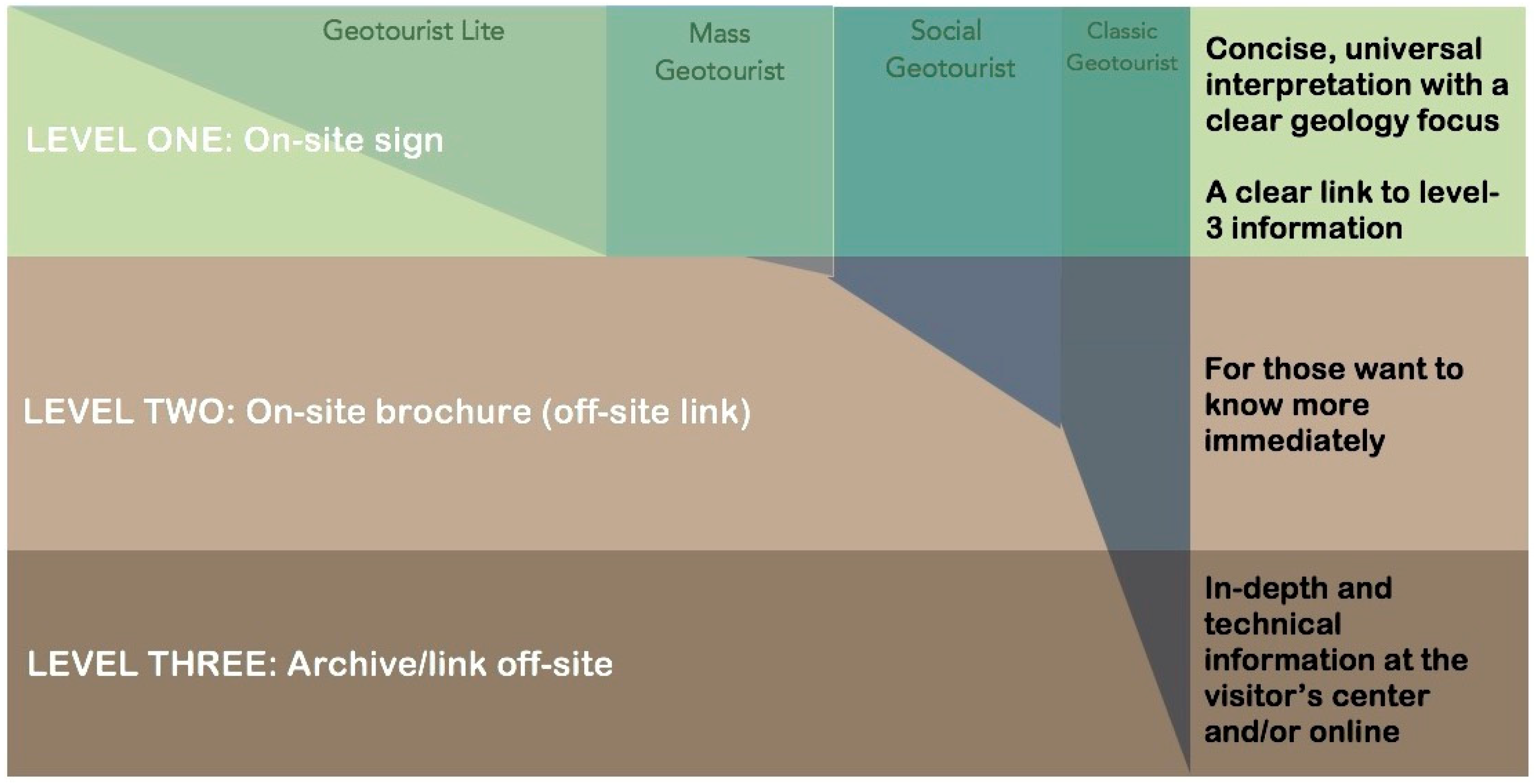
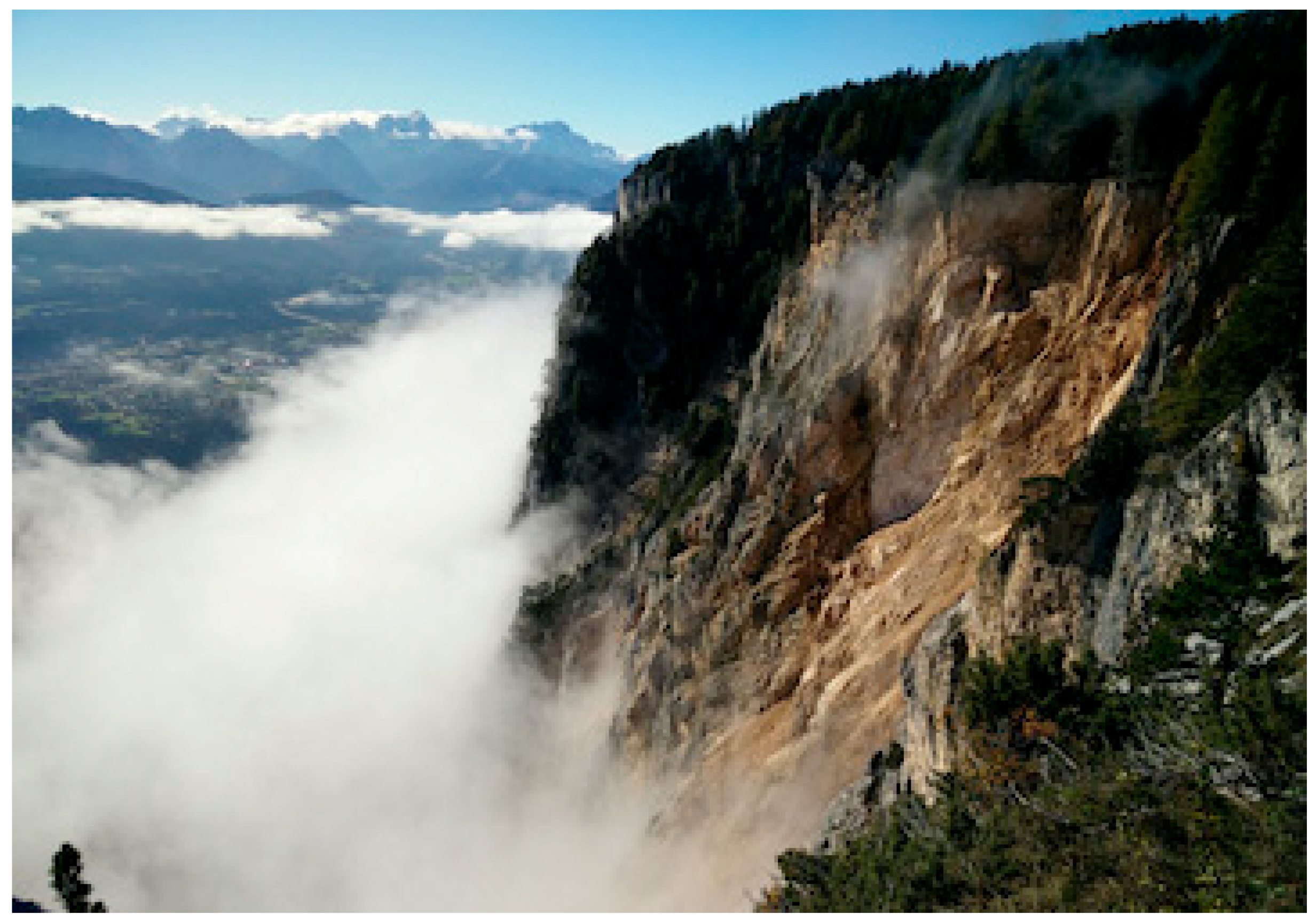
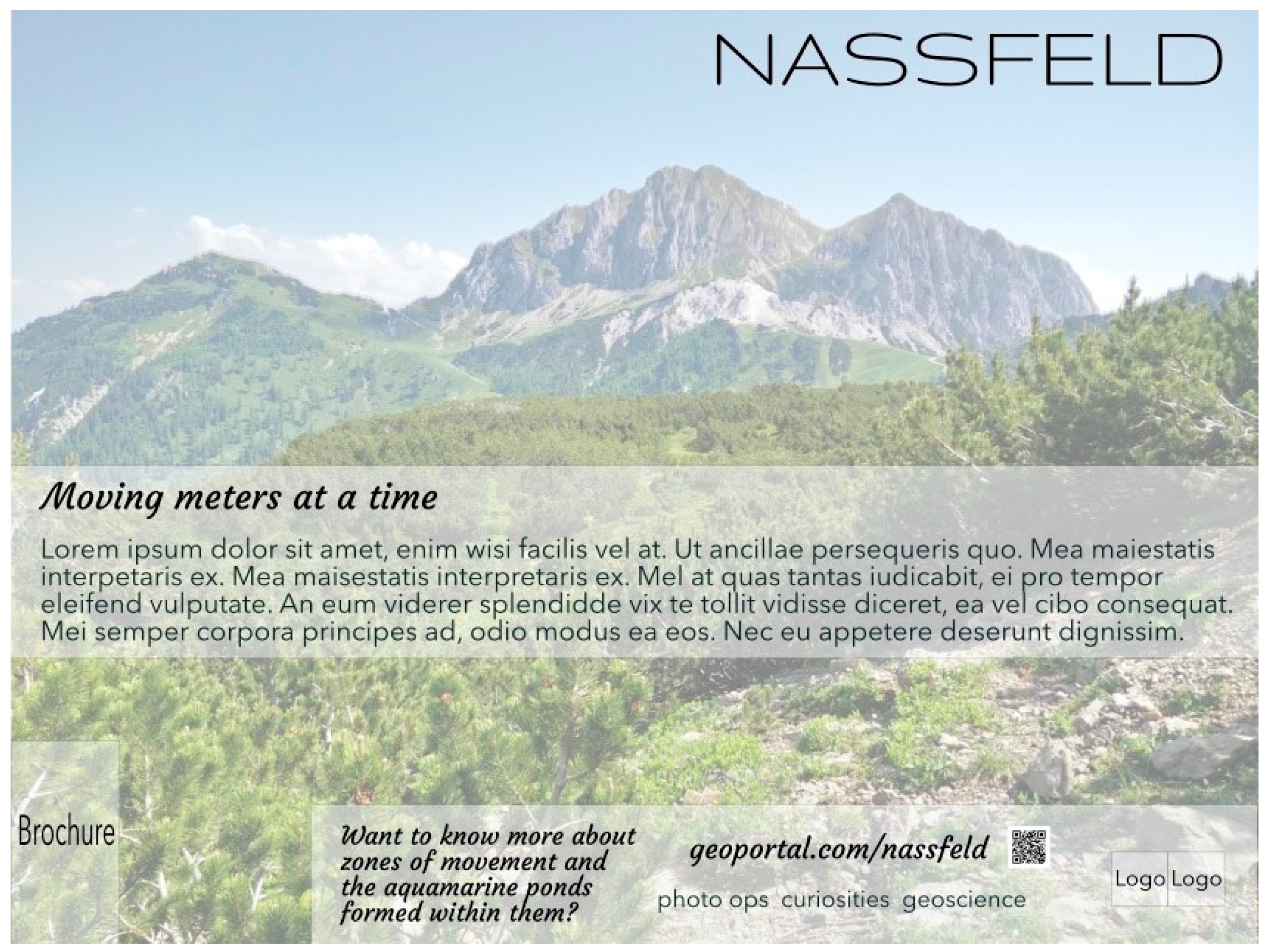
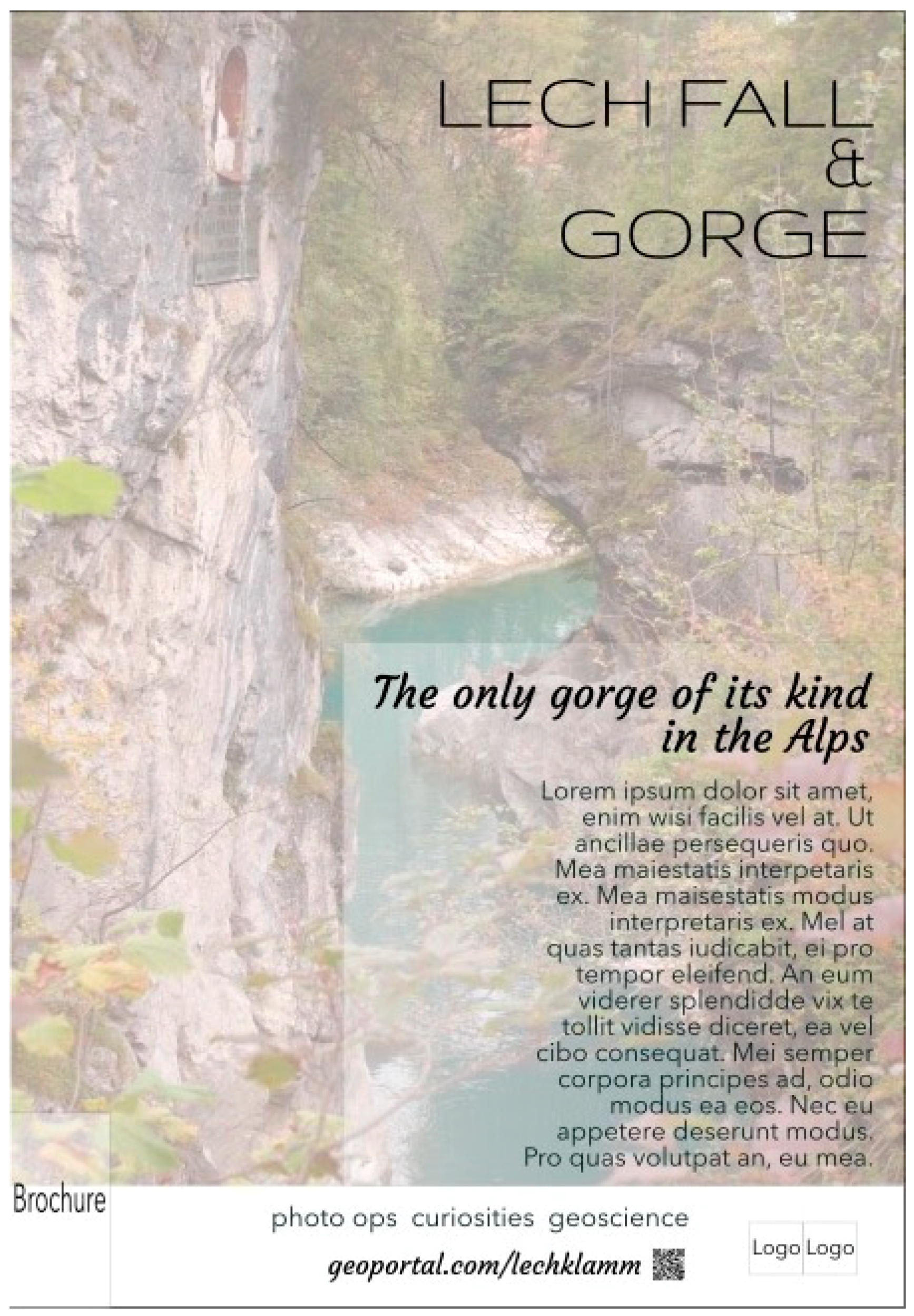
| Factor | Considerations | Related Research |
|---|---|---|
| Mechanics | Number of words Number of topics Type of content (i.e., technical, thematic) Visual communication (i.e., graphic design) Attracting, holding power Display/installation | Rodriguez Estrada and Davis [28]; Wandersee and Clary [45] Bitgood et al. [46]; Thompson and Bitgood [47]; Megerle [48] |
| Interpretive writing | Text composition | Tilden [36]; Megerle [48]; Ham [49]; Beck and Cable [50]; Skibins [51] |
| Outcomes | Learning (teaching, raising awareness) Behavioral (guiding actions) Emotional (creating meaning) | Barrow [29]; Megerle [48]; Skibins [51]; Falk et al. [52,53] |
| Latent Geotourists | Archetypal Geotourists |
|---|---|
| Geotourist lite | Social geotourist |
| Mass geotourist | Classic geotourist |
© 2018 by the author. Licensee MDPI, Basel, Switzerland. This article is an open access article distributed under the terms and conditions of the Creative Commons Attribution (CC BY) license (http://creativecommons.org/licenses/by/4.0/).
Share and Cite
Prendivoj, S.M. Tailoring Signs to Engage Two Distinct Types of Geotourists to Geological Sites. Geosciences 2018, 8, 329. https://doi.org/10.3390/geosciences8090329
Prendivoj SM. Tailoring Signs to Engage Two Distinct Types of Geotourists to Geological Sites. Geosciences. 2018; 8(9):329. https://doi.org/10.3390/geosciences8090329
Chicago/Turabian StylePrendivoj, Sonja M. 2018. "Tailoring Signs to Engage Two Distinct Types of Geotourists to Geological Sites" Geosciences 8, no. 9: 329. https://doi.org/10.3390/geosciences8090329




